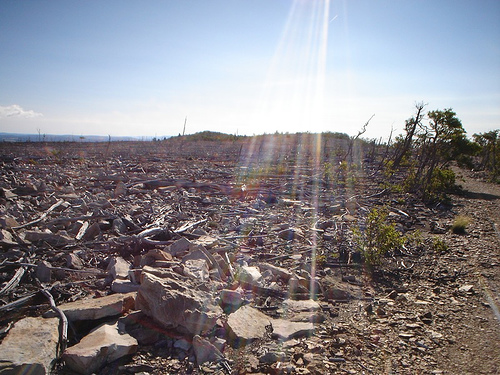Thirty years ago, an unprecedented number of children in Woburn, a community just north of Boston, were diagnosed with leukemia. This unfortunate incident sparked an environmental revolution of sorts, highlighted in the film A Civil Action. Although decades have passed in the cleanup through efforts of the Environmental Protection Agency (EPA), the site has yet to yield potable-standard water. The story portrayed in the film does not tell the whole tale. What was true of the Woburn story was the inability of government to address efficiently an environmental and health problem. Have we learned from our mistakes in Woburn since then? The current partisan debates surrounding the EPA suggest no.
Unbeknownst to residents, the Woburn water was contaminated by pollutants spewed from local factories such as W.R. Grace, a chemicals company, and a local tannery. These chemicals included trichloroethylene (TCE), a synthetic chemical which is known to cause cancer, detrimental reproductive effects, and both kidney and liver damage. At the time, well water was not regularly checked for contaminants; rather, it took nine cases of childhood leukemia and the deaths of two children to spark an investigation. This investigation revealed a compromised water supply, soiled by years of untracked pollution.
Granted, there was no reason for the authorities in Woburn to be concerned with their well water (though residents complained that it tasted funny); however, the lack of foresight in both disease prevention and environmental protection contributed to the rise of government agencies like the EPA, the Center for Disease Control and Prevention (CDC), and other regulatory bodies.
Since its inception, the EPA has implemented a program to clean up the nation’s most hazardous waste sites through a National Priorities List, which includes over 1,000 dangerous sites to human health that are first in line to be cleaned up. One of these cites is Woburn.[i] Dangerous, toxic chemicals that are detrimental to human health contaminate these sites, so the Superfund, as it is commonly referred to, provides federal dollars for the cleanup of these extremely high-risk zones. The EPA further attempts to reclaim these expenditures by pursuing those individuals or companies that are responsible for the initial pollution.
However, this process often takes decades, as it is often difficult to prove scientifically that there is a single source polluter for a site. In addition to this, there may not be any money left in the company to pursue legal recourse once a polluter is identified. Because of the myriad challenges facing cleanup, it is obvious that to avoid the numerous problems that arise when attempting to retroactively protect human health and hold polluters accountable for their actions, the best defense is just that: defense. Prevention is the primary method to avoid costly cleanups of toxic materials, and could have saved the lives of the two children in Woburn.
More recently, the EPA has been in the spotlight for attempting to regulate greenhouse gas emissions, smog-forming pollutants, and toxic chemicals in the air, arguably at the expense of business. In the race for the presidency given the economic downturn, several presidential hopefuls have pledged to eliminate the EPA altogether.[ii] Congress has also weakened the Clean Air Act, which prevents pollutants such as sulfur dioxide and nitrous oxides from entering our atmosphere, last year.[iii]
The simple reason for this rash of deregulation is jobs. Opponents to the Clean Air Act and the work of the EPA in general, argue that regulation destroys jobs. Fox Business News argues, “Opponents of proposed EPA rules on everything from automobile emissions to coal mines say that regulations would force companies to lay off workers or limit hiring more of them.”[iv] In an uneasy economic atmosphere where job creation will be crucial to the presidential race, these arguments will hold much weight.
Both major parties cite statistics on either job creation or destruction in conjunction with this now-controversial agency. However, the hidden reasoning for deregulation of the environment is industry. The Clean Air Act imposes requirements on industry for the installation of smokestack scrubbers, which catch pollutants before they exit the factory, and other costly measures. Arguably, this will add to production costs in domestic industry, thus making our producers less competitive than their unregulated counterparts in the developing world.
The EPA released a report outlining their cost-benefit analysis of the Clean Air Act amendments of 1990, projecting benefits and costs of the programs implemented by this law out to the year 2020. Compared to a hypothetical baseline assuming control programs of the 1970 and 1977 Clean Air Act amendments, the benefits of the 1990 amendments to the law would provide an estimated annual cost to society of $65 million. The benefits from improved air quality like avoidance of premature death and illness improved economic welfare to Americans, and better environmental conditions are estimated to be $2 trillion per year by 2020.[v] By this estimate, the benefits of reducing pollution through regulation dramatically outweigh the costs of implementation.
So the question remains, what is the role of EPA regulation today? For Woburn, the EPA entered too late and assisted in the cleanup of pollutants harmful to human health and safety. The Clean Air Act was passed to prevent this same mistake from occurring twice. If Americans believe that market economics will produce desirable results for collective national health as a facet of our production system, then the EPA is unnecessary. But if the United States recognizes that government exists to provide for our health and well-being, and that industry, by nature, will cut costs to a bare minimum as part of their fiduciary responsibility to maximize profit, then we might do well to learn from our own past mistakes.
Our failure in Woburn, and in most other EPA Superfund sites, was not placing a price tag on our common resources. Regulation was nonexistent, and there was no mechanism in place to prevent companies from negligently dumping toxic chemicals with no pre-treatment, allowing those chemicals to pollute a public resource and damage public health. Now that there is a regulatory agency in place to impose restrictions that can prevent the creation of toxic, harmful sites like those on the Superfund list, we have the capability to prevent further disasters and learn from our past mistakes.
[i] “Superfund.” United States Environmental Protection Agency. Web. 15 Nov. 2011. <http://www.epa.gov/superfund/>.
[ii] “Herman Cain Would Eliminate EPA.” Fox News Video News. Web. 11 Nov. 2011. <http://video.foxnews.com/v/1176885406001/herman-cain-would-eliminate-epa/>.
[iii] Anderson, David, Robert Merchant, and Paul Smith. “Weakened Clean Air Puts Lives at Risk.” The Montana Standard 12 Oct. 2011. Print.
[iv] Tracy, Ryan. “In EPA Debate, Both Sides Focus on Jobs.” Fox Business News. 8 Feb. 2011. Web. 27 Oct. 2011. <http://www.foxbusiness.com/markets/2011/02/08/epa-debate-sides-focus-jobs/>.
[v] The United States Environmental Protection Agency Office of Air and Radiation. “The Benefits and Costs of the Clean Air Act from 1990 to 2020.” The United States Environmental Protection Agency. Web. Mar. 2011. <http://www.epa.gov/air/sect812/feb11/summaryreport.pdf>.



